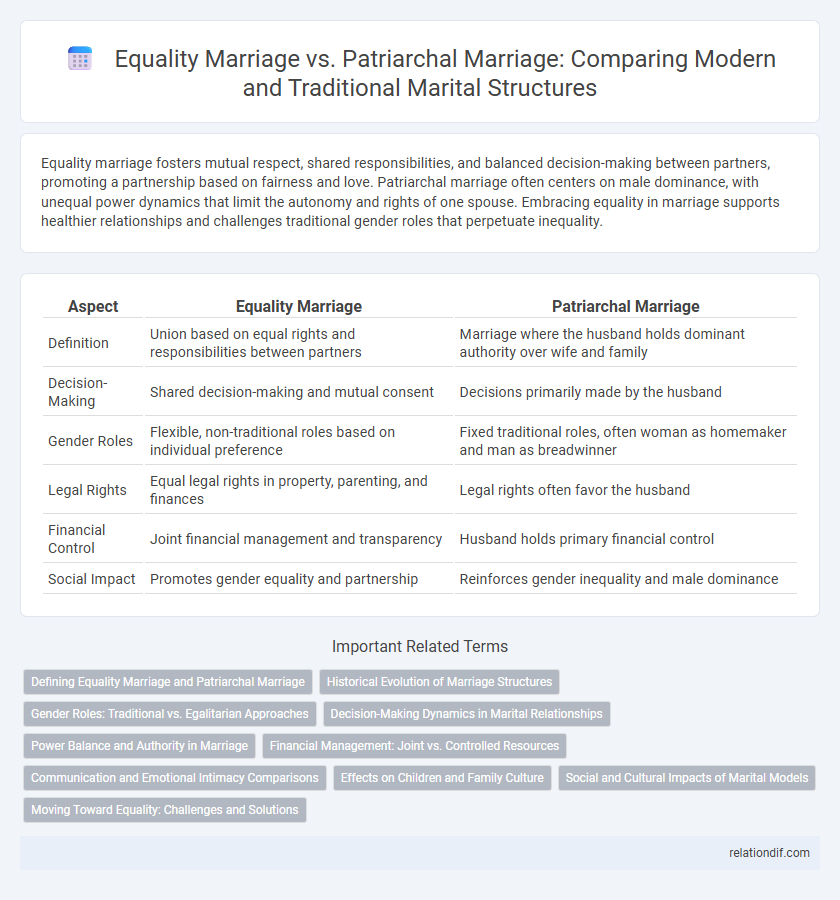Equality marriage fosters mutual respect, shared responsibilities, and balanced decision-making between partners, promoting a partnership based on fairness and love. Patriarchal marriage often centers on male dominance, with unequal power dynamics that limit the autonomy and rights of one spouse. Embracing equality in marriage supports healthier relationships and challenges traditional gender roles that perpetuate inequality.
Table of Comparison
| Aspect | Equality Marriage | Patriarchal Marriage |
|---|---|---|
| Definition | Union based on equal rights and responsibilities between partners | Marriage where the husband holds dominant authority over wife and family |
| Decision-Making | Shared decision-making and mutual consent | Decisions primarily made by the husband |
| Gender Roles | Flexible, non-traditional roles based on individual preference | Fixed traditional roles, often woman as homemaker and man as breadwinner |
| Legal Rights | Equal legal rights in property, parenting, and finances | Legal rights often favor the husband |
| Financial Control | Joint financial management and transparency | Husband holds primary financial control |
| Social Impact | Promotes gender equality and partnership | Reinforces gender inequality and male dominance |
Defining Equality Marriage and Patriarchal Marriage
Equality marriage is a legal and social union where partners share equal rights, responsibilities, and decision-making power, reflecting mutual respect and partnership. Patriarchal marriage designates a system where authority and control predominantly rest with the husband, often reinforcing traditional gender roles and limiting the wife's autonomy. These contrasting definitions highlight fundamental differences in power dynamics and gender equality within marital relationships.
Historical Evolution of Marriage Structures
Marriage structures have evolved from patriarchal systems, where authority and property passed through male lineage, to modern frameworks emphasizing equality between partners. Historical shifts include the decline of arranged marriages and the rise of individual consent, reflecting broader social movements for gender equality and human rights. Legal reforms worldwide now recognize equality marriage as a fundamental right, transforming traditional marital roles and promoting partnership based on mutual respect and shared responsibilities.
Gender Roles: Traditional vs. Egalitarian Approaches
Equality marriage promotes egalitarian gender roles where responsibilities and decision-making are shared equally between partners, fostering mutual respect and partnership. Patriarchal marriage reinforces traditional gender roles, assigning men dominance and leadership while women primarily manage domestic duties, often limiting women's autonomy. This shift from patriarchal to egalitarian marriage models highlights the importance of balanced power dynamics and gender equality in modern relationships.
Decision-Making Dynamics in Marital Relationships
Equality marriage promotes shared decision-making where both partners actively participate in choices regarding finances, career, and family planning, fostering mutual respect and collaboration. Patriarchal marriage often centralizes decision-making authority with the husband, reinforcing traditional gender roles and limiting the wife's influence in key marital and household decisions. Studies indicate that couples practicing egalitarian decision-making report higher satisfaction and healthier communication patterns compared to those adhering to patriarchal structures.
Power Balance and Authority in Marriage
Equality marriage ensures balanced power dynamics where both partners share decision-making responsibilities and authority, promoting mutual respect and cooperation. Patriarchal marriage typically centralizes authority with the husband, creating an imbalance that often limits the wife's autonomy and influence in family matters. This power imbalance in patriarchal structures can hinder emotional intimacy and equitable partnership.
Financial Management: Joint vs. Controlled Resources
Equality marriage emphasizes joint financial management, where both partners share control over income, expenses, and savings, fostering transparency and mutual decision-making. Patriarchal marriage typically involves controlled resources, with one partner, often the husband, managing finances and making key economic decisions, which can limit financial autonomy for the other spouse. Shared financial responsibility in equality marriages promotes trust and economic partnership, while controlled financial systems in patriarchal models may reinforce dependency and power imbalances.
Communication and Emotional Intimacy Comparisons
Equality marriage fosters open communication and mutual emotional support, emphasizing shared decision-making and vulnerability between partners. Patriarchal marriage often involves hierarchical communication patterns where one partner's voice dominates, limiting emotional intimacy and authentic expression. Studies show that couples in equality marriages report higher satisfaction and deeper emotional connection due to balanced dialogue and empathetic engagement.
Effects on Children and Family Culture
Equality marriage fosters a nurturing environment where children benefit from balanced parental roles, promoting emotional security and open communication. Patriarchal marriage often enforces rigid gender roles, which can limit children's understanding of gender equity and affect family dynamics. Research indicates that children raised in equality marriages exhibit higher emotional intelligence and adaptability within diverse social settings.
Social and Cultural Impacts of Marital Models
Equality marriage fosters mutual respect and shared decision-making, promoting gender equity and challenging traditional power dynamics deeply embedded in many cultures. Patriarchal marriage often reinforces gender roles, limiting women's autonomy and perpetuating social hierarchies that affect family structures and community interactions. These contrasting marital models significantly influence societal attitudes towards gender, impacting laws, education, and economic opportunities.
Moving Toward Equality: Challenges and Solutions
Moving toward equality in marriage requires addressing deeply ingrained patriarchal norms that perpetuate gender roles and power imbalances. Legal reforms, education on gender rights, and open communication between partners serve as critical solutions to dismantle traditional hierarchies. Social acceptance of egalitarian relationships encourages shared responsibilities and mutual respect, fostering healthier, more balanced marriages.
Equality Marriage vs Patriarchal Marriage Infographic

 relationdif.com
relationdif.com